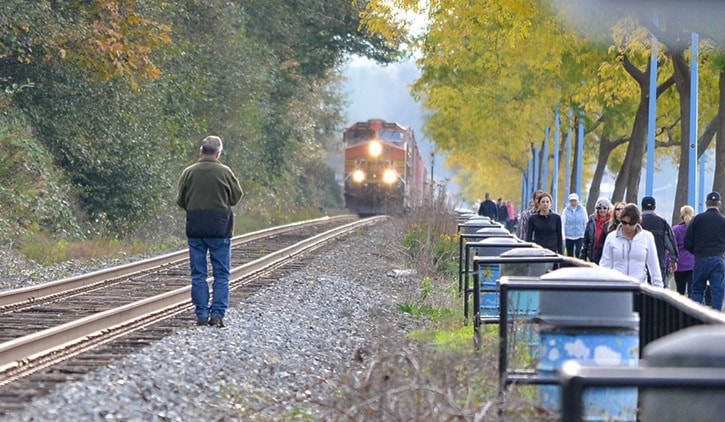If White Rock wants to keep train whistling to a minimum along its waterfront, it will have to spend $1.8 million for upgrades to its pedestrian crossings.
Greg St. Louis, the city’s director of engineering, said Friday that figure is a consultant’s cost estimate of installing flashing lights, signals and gates at each of the six pedestrian crossings of tracks that parallel the promenade – all of which is necessary if White Rock wants to keep its ‘quiet zone.’
The work was determined through a comprehensive review that was mandated by Transport Canada last fall in the wake of the July 14 death of a jogger who was struck and killed by a train on East Beach.
The review was to focus on improving pedestrian safety along the tracks, and include a look at the whistle-cessation policy that has restricted overnight train whistling along the waterfront since mid-1992.
Six reports – one per crossing – outlining the work are to be discussed in detail Wednesday during a meeting between officials representing the federal agency, the city and BNSF.
The $1.8-million estimate, St. Louis noted, does not include an additional $700,000 in work that is expected to be required within seven years of new safety guidelines that are anticipated to be announced by Transport Canada in the near future.
“That $1.8 million is for flashing lights, bells and everything” at the Finlay, Ash, Balsam, Cypress and Bay street crossings, as well as a gate at the pier-head crossing, St. Louis said.
If Transport Canada is satisfied with the proposed upgrades – and BNSF agrees – it will take 10 to 12 months to complete the work, which would be undertaken by BNSF and paid for by White Rock.
“BNSF said they have not paid… in Canada or the U.S. for any rail crossing because it is (for) the benefit of the road authority – or us – the crossing, and not their benefit,” St. Louis explained.
The findings were the subject of much discussion Thursday, at a meeting of the city’s new rail-safety task force.
Chaired by Coun. Grant Meyer, the group’s mandate is to help “guide the process of improving rail safety in White Rock in consideration of the issues of pedestrian safety, the rerouting of dangerous goods, and air quality from coal trains and diesel emissions.”
Meyer noted pedestrian safety is the task force’s biggest issue. He suggested – and Couns. Al Campbell and Larry Robinson agreed – simple, inexpensive steps should be taken to address concerns until more extensive work can be done.
“We can clean them up a little, we can get some bigger, bolder signs,” Meyer said. “But I think it’s got to be pretty blunt… ‘look, listen, live.’”
Other suggested work includes removing stairs from the Finlay Street crossing – where the summer fatality occurred – to direct pedestrians to use the switchback ramp. That step, which Robinson said was recommended by victim Anita Lewis’s loved ones, forces users to look both ways.
The group also discussed alternate routes for dangerous goods. Council resolved last year to request advance notice of trains carrying dangerous goods, to allow emergency responders to better prepare.
Exploring alternative routes for trains carrying oil and other dangerous goods was one of three recommendations announced Thursday by the Transportation Safety Board of Canada and the U.S. National Transportation Safety Board. The task force plans to discuss the issue Friday with MP Russ Hiebert.
